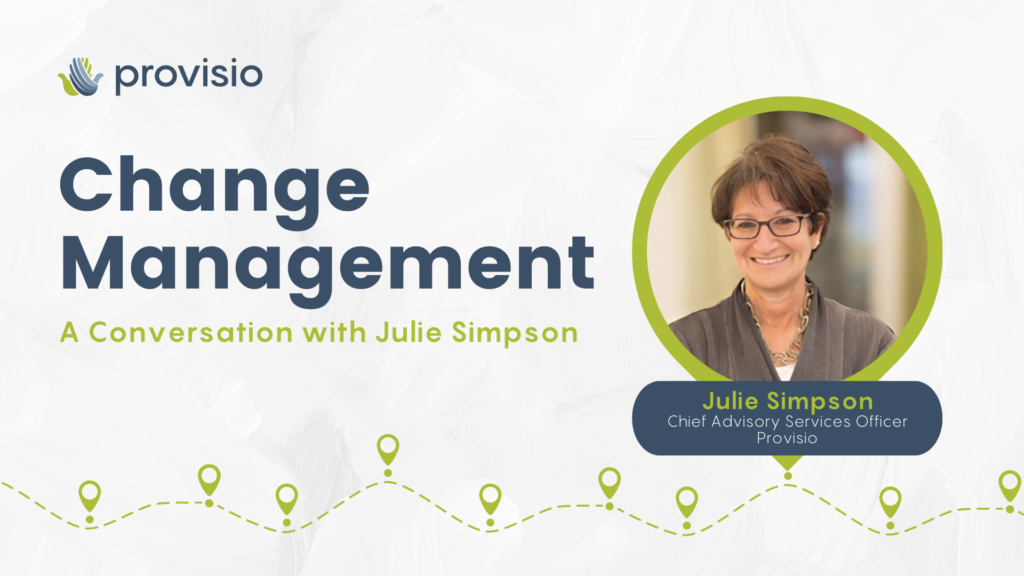Provisio recently hosted a Tech Trek about empowering your organization’s growth with Salesforce. Since much of the content involved the change management topic, I wanted to sit down with our Change Management Guru (or Chief Advisory Services Officer, if you prefer her more formal title), Julie Simpson, to learn more. Read on to learn about Provisio’s approach to change management.
Question: We hear the term change management often. How do YOU define it?
We define “change management” as the intentionality and care an organization must offer its team members when shifting processes, practices, or policies, to ensure the humans impacted can not only be aware the change is happening but are able to champion the change by contributing, as appropriate, to how it will most appropriately and respectfully be handled.
Question: What are the biggest challenges organizations face as they seek to institute any type of change (for example, leadership, staffing, technology, policy, data collection, or reporting)?
Organizations get into trouble with change management, or experience resistance to change, for several reasons. Most common are:
1) Lack of timely communication due to leadership’s need to “control” who knows what across the organization (assuming that, if they withhold certain information, it will be less upsetting to staff than increased transparency and advance notice).
2) Lack of clarity on exactly which stakeholders will be able to weigh in about how (not whether) the change happens.
3) Inability for leadership to think through how the change will directly and indirectly impact each team member’s day-to-day experience; and most importantly,
4) A sense on the part of team members that their voices or opinions don’t matter.
Question: What types of organizations does Provisio’s Advisory Services help?
We support nonprofits, public sector agencies, and philanthropies in managing change. For each, it’s a combination of ensuring leadership are aligned on the purpose of the change and the messaging to be shared with all team members, and carefully identifying those team members who will serve as the champions or ambassadors for the change!
Question: And what types of support are these organizations seeking?
We typically identify issues organizations who are going through change may not have considered, e.g., using existing communications vehicles to remain as transparent as possible about change before it occurs; which departments or staff might need a bit more support than others; and how individuals who will serve as change champions can lighten their day-to-day loads to have enough bandwidth to support their colleagues. We also assist in mapping detailed “change calendars” to ensure communications are timed appropriately and meetings are established with the right cadence to guarantee timely awareness for all stakeholders. It’s also not uncommon for us to support the convening of change management task force meetings and full organizational leadership meetings designed to smooth alignment and acceptance of new practices and policies.
Question: How do organizations prioritize which changes to implement first when multiple changes are necessary?
Every organization going through change is starting from a slightly different launchpad. We familiarize ourselves fully with all aspects of an organization’s culture, history, risk and change aversion, and assets to make sure we support the most respectful and appropriate set of change management tools and practices for each individual group we work with. We co-create a change management plan alongside our clients and adjust as needed throughout the engagement.
Question: Can you share an example of a successful change management project you have led? What were the key factors that made it successful?
Provisio recently provided change management support for Friends of the Children (FoTC), a large national nonprofit. FoTC supports youth identified through the foster care system, community-based organizations, and schools who lack the essential supports and family resources required to succeed as young adults and thrive, by pairing them with professional mentors for a 12+ year period. FoTC has grown tremendously over the past few years and has 37 distinct locations nationwide. Provisio was engaged to make it possible for FoTC to measure its longitudinal impact by designing and implementing a unified Salesforce technology solution. By ensuring diverse stakeholder representation on a change management task force, facilitating timely and respectful communication, and guiding FoTC’s senior leadership through this enormous digital transformation, Provisio enabled FoTC to move through this network enhancement process with optimal inclusion, transparency, and respect for the leaders across the country who would be most directly impacted by this change.
Question: How do organizations keep their momentum and sustain change over the long term?
We excel at building organizations’ own change management and “adaptive capacity,” i.e, the ability to know when change is required, what’s needed to streamline the change, how to deputize which team members to serve as change ambassadors (depending on the type of change occurring), how to gather information while the change is happening to know whether change management efforts are working, and to adapt processes as needed as a result of what is learned.
If you would like to hear more about change management and how to become a stronger learning organization, you can watch the “Empower Your Organization’s Growth: Harnassing Salesforce for Continuous Learnig and Evolution” recording here!

Marjorie lives in Saint Louis, Missouri. She received her Master’s degree in English from Truman State University. Her responsibilities at Provisio Partners include content creation and technical writing.

